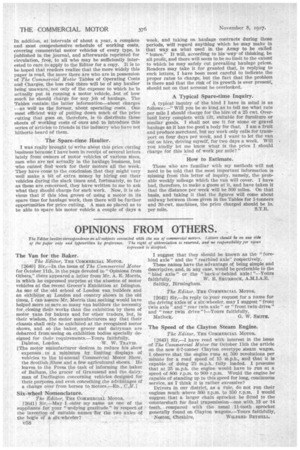OPINIONS FROM OTHERS.
Page 116

If you've noticed an error in this article please click here to report it so we can fix it.
The Editor invites correspondence on all subjects connected With the use of commercial motors. Leiters should be on one side of the paper only and typewritten by preference. The right of abbreviation is reserved, and no responsibility for views
expressed is dccepted.
The Van for the Baker.
The Editor, Tug COMMERCIAL MOTOR.
[2640] Sir,—In the issue of The Commercial Motor for October 111..h, in the page devoted to " Opinions from Others," there appeared a letter from Mr. A. E. Morris, in which he expressed surprise at the absence of motor vehicles at the recent Grocer's Exhibition at Islington. As one of the old school of London van builders and an exhibitor at London and country shows in the old times, I can assure Mr. Morris that nothing would have helped more to save,so many, van builders the necessity for, closing their works than the exhibition by them of motor yans for bakers and for other traders, but, in their wisdom, the motor manufacturers say that their chassis shall only be exhibited at the recognized motor shows, and so the baker, grocer and dairyman are debarred from seeing on exhibition bodies specially designed for their requirements.—Yours faithfully,
Dalston, London. W. W. TRAVIS.
[The motor manufacturer -desires to reduce his show expenses to a minimum by limiting displays of vehicles to the bi-annual Commercial Motor Show, the Scottish Show and a few agricultural shows. He leaves to the Press the task of informing the baker of Balboni, the grocer of Gravesend and the dairy,man of Darlington concerning vehicles designed for their, purposes and even concerning the advantages of a change. over from horses to motors.—En., C.M.1 Six-wheel Nomenclature.
The Editor, Thu COMMERCIAL MOTOR.
12641] Sir,—May I enter my name as one of the suppliants' for your "undying gratitude" in respect of the invention of suitable names for the two axles of „ . —
the bogie Of a six-wheeler? I suggest that they should be known as the " forehind axle" and the" rearhind axle" respectively.
These names have the advantage of being simple and descriptive, and, in any case, would be preferable to the "hind axle" or the " back-o'-hehind axle! "—Yours faithfully, W. B. SEURROCK, A.M.I.A.E. Saltley, Birmingham.
The Editor, TEE COMMERCIAL MOTOR.
[2642] Sir,—In reply to your request for a name for the driving axles of a six-wheeler, may I suggest "front twin axle " and "rear twin axle" or "front twin drive" and "rear twin 'drive "I—Yours faithfully, Matlock. G. W. SMITH.
The Speed of the Clayton Steam Engine.
The Editor, THE COMMERCIAL MOTOR.
[2643] Sir,—I have read with interest in the issue of The Commercial Motor for October 11th the article on the new 6-7-tonner Clayton overtype steam wagon. [observe that the engine runs at 500 revolutions per minute for a road speed of 15 m.p.h., and that it is capable of doing 25 m.p.h. fully loaded. I presume that at 25 m.p.h. the engine would have to run at a speed of 800 r.p.m. to 900 r.p.m. Would the engine be capable of standing up to this speed for long, continuous service, aS. I think it is rather excessive?
Drivers in our district, as a rule, do not rim their engines mita above 300 r.p.m. to 350 r.p.m. I would suggest that a. larger chain sprocket be fitted to the -cotintershaft for final transmission—one with 13 or 14 teeth, compared with the usual 11-tooth sprocket generally -found on Clayton wagons.—Yours faithfully,
Norton; Cheshire. WILFRED BETHELL.




















































































































































































